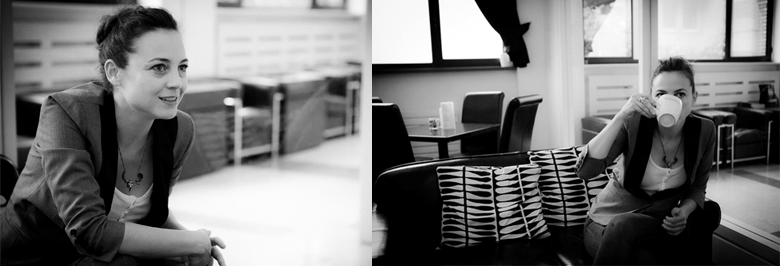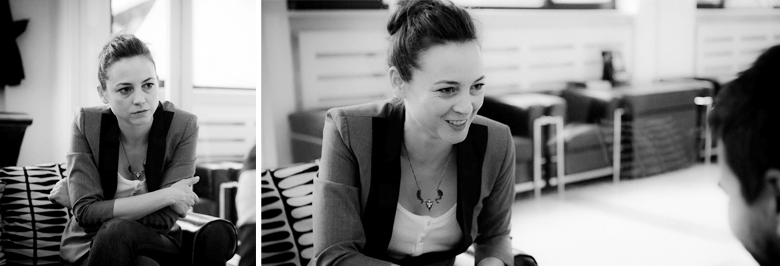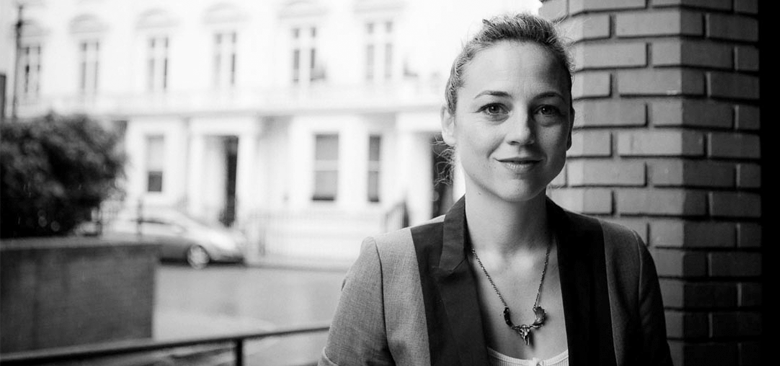Leonor Watling, the Spanish actress and singer (who has an English mother and a Spanish father) is without a doubt one of our most multitalented and driven actresses, creatively speaking. She jumps from one discipline to another as naturally as she does between her two mother tongues. Not only does she sing in the band Marlango, she has also brought us such characters as Elvira in “My Mother Likes Women” and that neighbour who S. Polley chooses to replace her after her death in Isabel Coixet’s moving “My Life Without Me”.
Leonor Watling, the Spanish actress and singer (who has an English mother and a Spanish father) is without a doubt one of our most multitalented and driven actresses, creatively speaking. She jumps from one discipline to another as naturally as she does between her two mother tongues. Not only does she sing in the band Marlango, she has also brought us such characters as Elvira in “My Mother Likes Women” and that neighbour who S. Polley chooses to replace her after her death in Isabel Coixet’s moving “My Life Without Me”.
Thanks to the London Spanish Film Festival, we’ve managed to grab 15 minutes to chat to her. We head to a café for a coffee and a smoke – what a treat.
The conversation is comfortable, fluid and full of laughter. She has come over to present her film “The Food Guide to Love”, a comedy in which she plays Bibiana, a Spanish art curator who falls in love with Oliver (Richard Coyle), a famous food critic from Dublin, in the throes of an emotional crisis.
She is thoroughly captivating with her shrewd gaze, the measured pace of her speech and her natural sensuality which doesn’t go unnoticed despite the fact that she is used to posing and making sure that the cameras catch her good side. Sexy, cultured and interesting to talk to, she answers all of our questions.

Fotos © Noela Roibás
How was filming and being directed by a married couple? Did they disagree on anything? Not at all, they were a unit, they never argued, and believe me we tried to pit them against each other [laughs]. I think that the actor is always like a little child around the director – you try to see how far you can push it and how far they’ll let you do what you want. I think this is a natural, subconscious reaction from an actor, you can do it subtly or more overtly… you’re putting yourself in their hands. Any time Richard and I were trying to suggest a change, we’d ask one of them first, and then go ask the other one, but they had it all figured out so clearly it was like listening to the same record twice.
I grew up in Spain and coming here, I discovered things that helped me to understand where I come from, how I interact with other people and how my mother cooks.
So you (the actors) hardly ever got to make any contributions to the script. No, they had a very clear idea of what the film that they wanted to make. Actors always bring something to the table, but in this case they had very clear ideas about the film and characters.
You and Richard Coyle work fantastically well as a double act on the big screen. Did you know each other? What was it like working with him? We met here, a couple of months before filming started. We had a day of rehearsals with Teresa and Dominic and the next time we saw each other was in Dublin. I loved working with him, he’s an incredible actor, very generous. It’s weird because although he’s a great comedic actor, with such a striking physicality, he also has a dramatic background — he’s a very good theatrical actor. It’s a very nice mix because in 0.3 milliseconds he can switch from the most intense physical humour to immediately compose himself and change register and this fantastic to see in an actor. As an actor, he is always on the ball.
The Food Guide to Love is a joint production between Ireland, Spain and France, with British, Irish and Spanish actors… What was it like working with such a multicultural team? What advantages does it being to the project? And how does it make things more complicated? I don’t really notice nationalities. I believe that our differences lie in every professional’s personal differences and the type of films they work on. If you work in the US with a budget of 10 thousand million dollars per film, then you’re used to making a type of film which is altogether different from European films made on a smaller budget. Whether you’re Irish, Catalan, Spanish or English, I find it difficult because more and more emphasis is put on it every time when I think it should be the other way around…

Fotos © Noela Roibás
So, European or American cinema? I like making cinema, I like telling stories. With productions with loads of money, you can lose that feeling of craftsmanship that you get with films which have smaller budgets. They’re different approaches, one’s more industrial and one’s more artisanal, but at the end of the day, the end product is the same – cinema.
You trained as an actress at the Actors Centre in London (according to Wikipedia). Wikipedia sometimes says things which I don’t… but yes, I did go to the Actors Centre. I went to Cristina Rota and Coraza and after that, the Actors Centre.
Tell us about your experiences from back then. I studied with Coraza and Cristina Rota a lot more than I did in England at the Actors Centre, where I did some seminars. In England, when I came to enrol, I was already working, and sure… you’ve had a three-year-long career and you have to go to school 12 hours a day… and you can’t work. That’s why I opted for the Actors Centre and immediately I met more people who were like me! I grew up in Spain and coming here, I discovered things that helped me to understand where I come from, how I interact with other people and how my mother cooks.
Actress, singer, songwriter and you’ve even gone behind the cameras, co-directing the music video to “Lo que sueñas vuela” with Rómulo Aguillaume. Which role do you feel most comfortable in? At home with my family [laughs]. I don’t know what to say… I really like performing, it fascinates me, hurts me, I’m drawn to it and it frustrates me all at the same time. I also need to write, it’s a vice, an opportunity to let off steam. It’s a chance to be able to sit down and let loose. And singing is a real pleasure… And then in amongst all this, there’s the tough stuff, like going on tour and sitting in a van for eight hours at a time, or being away from home for 2 weeks. Every profession, even vocational ones have to deal with these downsides sometimes, but you can’t get away from them, can you?
I really like performing, it fascinates me, hurts me, I’m drawn to it and it frustrates me all at the same time.
Which director or directors would you like to work with or work with again? To be honest, with any who’d like to work with me. There is nothing nicer than working with a director that really wants to work with you.
How long will we have to wait for a Marlango concert over here in the UK? Well, I’m not sure really. The truth is that we go wherever we’re taken, you don’t really get to decide where you play, it depends on the promotor, on a person who tells you to go here or there. It’s weird, we’ve toured Germany, Argentina, Chile, Italy, but we’ve yet to go to London and England, it’s weird…
Getting back to the film, one of the funniest scenes in the film is when you are having a food fight in the kitchen… Yes, everyone loves that one! It must be some sort of taboo that we all have [laughs].
What was it like filming that scene? Was it as fun as it looks or did you eventually get fed up with all the flour? We only shot the scene once, for a number of reasons. One was our budget and also having to reset a scene like that would take about 3 hours. You’ve got to get showered, get your hair done, change clothes, clean the kitchen… and mostly the fact that the whole team was very eager for they to end [laughs] and to do it well in one take. There were two cameras and Richard was like ‘we have to this in one shot Leonor!’, [laughs] ‘concentrate on it!’.
We rehearsed it a lot, we had it worked out quite well… subconsciously, you know that you should be wary of the cameras but once you start getting ketchup poured all over your head, you lose your sense of dignity a little and you get used to it. It’s loads of fun, because it flies in the face of what you’ve been taught your whole life and you hear a little voice in your head saying “don’t throw food”, very funny, I would have done it more often! [laughs]. Would you ever do it in real life? No, because I’m very lazy when it comes to cleaning and I would just be thinking ‘I’ll have to clean all of this up later on’.
– – – – – – – – – – –
Interview coordinated by Carolina Núñez.
Interviewer: Ángel Villalba
Photos © Noela Roibás

